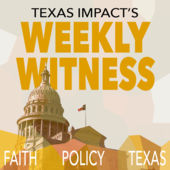Taxes, Public Education, and Health Care
Before each legislative session, Texas Impact’s board of directors sets Texas Impact’s Legislative Agenda. Texas Impact’s board is a delegation appointed by the religious denominations and organizations that make up Texas Impact’s membership. Texas Impact staff are responsible for lobbying and mobilizing our members to advocate for or against particular bills based on the board’s legislative agenda.
During the 86th Legislative Session, Texas Impact tracked 1,570 bills; closely monitored 187; and took public positions on 97 bills, supporting 79 and opposing 18. This is a summary of the highlights of the 86th Legislative Session categorized by issue area.
Allocating the State’s Financial Resources: Taxes, School Finance, and Health Care
The only bill the Texas Legislature is constitutionally required to pass is a state budget. The 86th Texas Legislature passed HB 1, the biennial (two-year) budget for fiscal years 2020-2021. HB 1 totals almost $251 billion. Of the $251 billion, almost $119 billion is budgeted to come from state general revenue. You can find detailed information about the state budget on the website of the Texas Legislative Budget Board.
School finance and property taxes were the top priority of the state’s leadership, and were addressed in HB 3 and Senate in SB 2, respectively. HB 3 and SB 2 account for almost all of new spending. HB 3 allocates $4.5 billion in new funding to public schools, $2 billion in teacher compensation, and more than $5 billion to reduce local property taxes, for a total cost of $11.6 billion in new spending. HB 3 also alters the formula for recapture, colloquially known as Robin Hood. Overall, the state is now paying 45 percent of the total cost of public education, which is up from 38 percent. However, the Legislature paid for the increase in the state’s share using surplus revenues which were available because the economy has been thriving, raising questions about how lawmakers will maintain the new spending in future biennia, particularly in the event of an economic downturn. To read more about HB 3, see the Center for Public Policy Priorties’ blog.
Legislators balked at a proposal by Governor Abbott, Lt. Governor Patrick, and Speaker Bonnen to raise the sales tax by 1 cent in HJR 3 to pay for property tax cuts. The public turned on the plan quickly, with widespread rejection of such a regressive tax. However, legislators did pass HJR 38 to prohibit an income tax. HJR 38 would supercede the existing constitutional provisions put in place by Lt. Gov. Bullock in the 1990’s, which ensured that if Texas ever enacted an income tax, it would only be used to offset property taxes and fund public education. The public will vote on the constitutional change HJR 38 proposes in the constitutional election in November.
The Texas House voted to eliminate the local property tax in HB 297, although the bill failed in the Senate. HB 297 would have carried a $58 billion fiscal note and observers were shocked that the House moved the bill forward.
Most states rely on “a three legged stool” to generate revenue for public purposes, consisting of income, sales, and property taxes. Having rejected the income tax, refused to increase the sales tax, and reduced the property tax, the Legislature then tied the hands of local elected officials, including public school districts, in SB 2, by hobbling local elected officials’ ability to raise revenue locally. SB 2 caps property taxes at 2.5 percent for school districts and 3.5 percent for cities and counties. Between the tax caps, no new funding mechanism, and a reworking of the Robin Hood formulas which are projected to increase inequity over the next decade, a future revenue discussion is inevitable, and a school finance lawsuit seems to lurk over the horizon.
With public education and property tax reform firmly ensconced as the top legislative priorities, there was little bandwidth available for health care, although House members filed a number of bills that would have improved access to care. HB 342 by Rep. Philip Cortez would have provided 12 continuous months of coverage for children on Medicaid, ending the current administratively cumbersome requirement that parents renew their children’s healthcare coverage every 6 months—but the bill met its demise in the Senate. HB 744 by Rep. Toni Rose would have provided 12 months continuous coverage for women postpartum—a top recommendation of the much-reported state task force on maternal mortality. It too failed to pass the Senate. HB 2032 by Rep. John Turner would have created a health literacy advisory committee to promote health care literacy, to help health insurance consumers get maximum, value from their insurance…but died in Senate. And many of the initiatives Rep. Sarah Davis championed to address harmful HMO practices reported by the Dallas Morning News in their Pain & Profit series met their demise in the Senate or caught last-minute rides as amendments on other bills.
There were exceptions to the rule: HB 25 by Rep. Mary Gonzales creates a pilot program to allow mothers to take their children on the bus provided by the Medicaid transpiration program. SB 556 by Sen. Lois Kolkhorst, which creates a pilot program to provide basic dental services to individuals with severe disabilities, survived as an amendment to a larger pilot program for Texans with disabilities in HB 4533 by Rep. Stephanie Klick. And progress continued, with SB 1264 by Sen. Kelly Hancock, against the practice of hospitals’ “surprise billing,” an increasingly common phenomenon nationally in which patients who are treated by doctors who turn out not to be in the patients’ insurance networks.
Weekly Witness Podcast: All Faith, All Policy, All Texas
 For a deeper dive into the topic of this post, listen to Texas Impact’s “Weekly Witness” podcast on faith and policy in the Lone Star State.
For a deeper dive into the topic of this post, listen to Texas Impact’s “Weekly Witness” podcast on faith and policy in the Lone Star State.